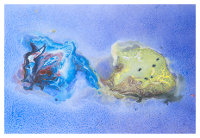Conveners
Parallel I: A1 Vacuum structure and confinement: Focus Subsection
- Manfried Faber (Vienna University of Technology)
Description
Applications of strongly interacting matter and chiral matter to material science.
Alexander Andrianov
(Saint Petersburg State University)
08/09/2014, 14:00
Section A: Vacuum Structure and Confinement
The low energy realization of QCD in terms of mesons is studied when an axial chemical potential is present; a situation that may be relevant in heavy ion collisions. We also consider the ‘two flavour’ Nambu–Jona-Lasinio model in the presence of a vector and an axial external chemical potential as a QCD replica and study the phase structure of the model at zero temperature. The presence of an...
Victor Braguta
(Institute for High Energy Physics)
08/09/2014, 14:30
Section A: Vacuum Structure and Confinement
The axial magnetic field, which couples to left- and right-handed fermions with opposite signs, may generate an equilibrium dissipationless energy flow of fermions in the direction of the field even in the presence of interactions. In this report numerical observation of the Axial Magnetic Effect in SU(2) lattice gauge theory is presented. The temperature behavior of the Axial Magnetic Effect...
Pavel Buividovich
(Regensburg University)
08/09/2014, 15:00
Section A: Vacuum Structure and Confinement
We study interacting Dirac fermions with chirality imbalance in the mean-field approximation and find that the chiral imbalance is strongly enhanced due to spontaneous chiral symmetry breaking. This result is valid both for the breaking of the exact chiral symmetry and for the pion condensation phase in the case of Wilson-Dirac fermions. We then consider the Chiral Magnetic Effect (CME) in the...
Victor Petrov
(Petersburg Nuclear Physics Institute)
08/09/2014, 15:30
Section A: Vacuum Structure and Confinement
We consider a model for the vacuum of pure glue theory based on dyons. Temperatures of confinement-deconfinement, string tensions and other physical quantities for different gauge groups and representations are calculated. The relation with supersymmetric confining theories is discussed.
Considered mechanism of confinement/deconfinement implies specific behavior of the effective potential...
